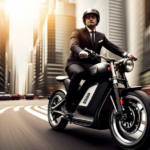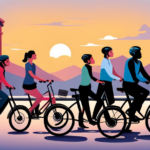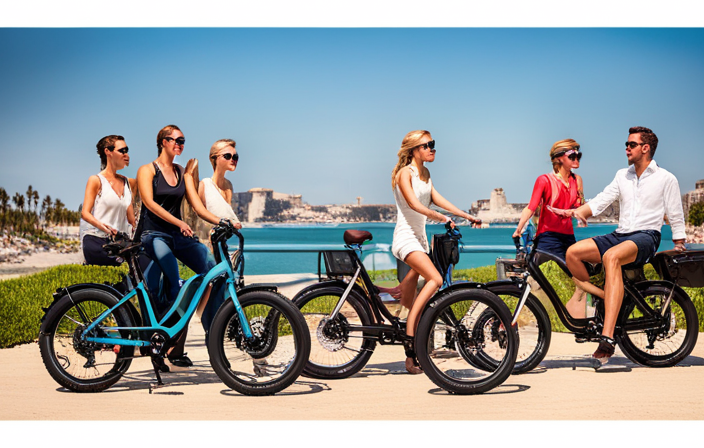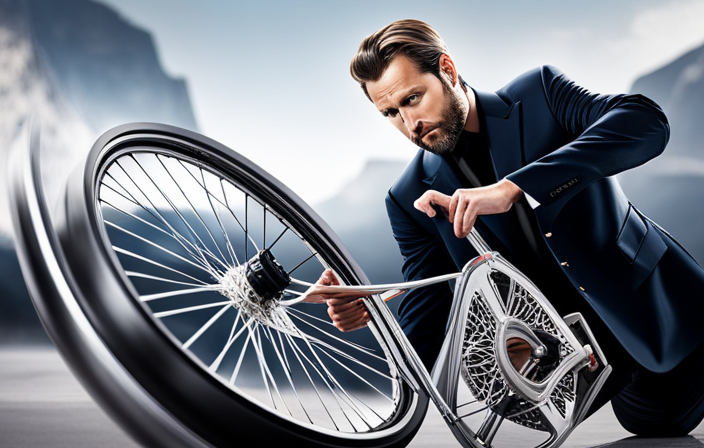As an avid electric mountain bike rider, I’m sure you’ve wondered how to make your bike street legal. Well, look no further! In this article, I will guide you through the steps to ensure your electric mountain bike meets all the necessary requirements.
From understanding local laws and regulations to installing the required safety equipment, we’ll cover everything you need to know.
So, hop on and let’s make your electric mountain bike roadworthy!
Key Takeaways
- Research and understand local laws and regulations for electric mountain bikes
- Determine specific modifications or additions needed to comply with regulations
- Classify your electric mountain bike according to Class 1, Class 2, or Class 3
- Install necessary safety equipment and ensure roadworthiness of the bike
Understand the Local Laws and Regulations
You’ll need to research and understand the local laws and regulations in your area to ensure you make your electric mountain bike street legal. It’s crucial to understand local requirements and research legal restrictions that may apply to your electric bike.
Each jurisdiction may have different rules regarding speed limits, power output, lighting, and licensing. Some areas may require registration or specific equipment like mirrors, horns, or turn signals. Researching local laws will help you determine the specific modifications or additions needed to comply with regulations.
Additionally, it’s important to note that these laws can change, so staying informed is essential. Once you have a clear understanding of the local requirements, you can proceed to check the classification of your electric bike, which will determine the specific regulations that apply to your situation.
Check the Classification of Your Electric Bike
To ensure your electric mountain bike meets the necessary requirements for street legality, start by checking its classification. Electric bikes are typically classified into three categories based on their power and speed capabilities. These classifications play a significant role in determining the legal requirements for your electric bike.
Here are the two sub-lists to help you understand the deeper meaning of electric bike classification and legal requirements:
-
Classification Types:
- Class 1: Pedal-assist electric bikes with a maximum speed of 20 mph.
- Class 2: Electric bikes with a throttle and a maximum speed of 20 mph.
- Class 3: Pedal-assist electric bikes with a maximum speed of 28 mph.
-
Legal Requirements:
- Different states and countries may have specific laws regarding electric bike classification.
- Understanding the classification of your electric bike will help you determine if it meets the legal requirements for street use.
Install the Required Safety Equipment
Once you understand the classification of your e-bike, you can proceed with installing the necessary safety equipment.
When it comes to converting an electric mountain bike for street use, there are certain safety gear requirements that must be met.
First and foremost, you will need to install front and rear lights for increased visibility. These lights should be bright enough to ensure that other road users can see you clearly, especially during low-light conditions.
Additionally, it is crucial to have a horn or bell to alert pedestrians and vehicles of your presence.
Another important safety feature is mirrors, which allow you to have a clear view of the traffic behind you.
Lastly, don’t forget to equip your electric mountain bike with fenders to prevent mud and debris from splashing onto you or other riders.
With these safety measures in place, you can confidently ride your electric mountain bike on the street.
Moving forward, let’s discuss how to obtain the necessary licensing and registration for your e-bike.
Obtain the Necessary Licensing and Registration
Now that you understand the classification of your e-bike, it’s time to focus on obtaining the necessary licensing and registration. To make your electric mountain bike street legal, you need to understand the legal requirements and obtain the necessary permits.
Here are the steps you need to follow:
- Research the specific licensing and registration requirements in your jurisdiction.
- Contact your local Department of Motor Vehicles (DMV) or equivalent agency to gather all the necessary information.
- Complete the required paperwork, including application forms and any additional documentation.
- Pay the applicable fees and submit your application for licensing and registration.
By following these steps, you will ensure that your electric mountain bike meets all the legal requirements to be ridden on public roads.
Now that you have obtained the necessary licensing and registration, the next step is to ensure your bike is roadworthy.
Ensure Your Bike is Roadworthy
After obtaining the necessary licensing and registration, it’s important to ensure that your bike is roadworthy. Bike maintenance plays a crucial role in road safety.
Start by inspecting the tires for any signs of wear or damage. Check the brakes to make sure they are functioning properly and have enough pad material. Test the lights, including the headlight, taillight, and turn signals, to ensure they are all working. Verify that the horn is loud enough to be heard by other road users. Additionally, check the suspension and steering components for any looseness or play.
Regularly clean and lubricate the chain to prevent rust and ensure smooth operation. Finally, make sure all the electrical connections are secure and the battery is fully charged. By properly maintaining your bike, you can ensure a safe and enjoyable ride on the road.
Now, let’s move on to the next important aspect: purchasing insurance coverage.
Purchase Insurance Coverage
It’s crucial to purchase insurance coverage to protect yourself and your bike on the road. Electric bike coverage and insurance requirements may vary depending on your location, so it’s important to research and understand the specific regulations in your area. To give you an idea, here is an example table outlining the insurance requirements for electric bikes in a fictional city:
| Insurance Coverage | Minimum Coverage Limit | Deductible Amount |
|---|---|---|
| Liability Insurance | $100,000 | $500 |
| Comprehensive | $2,000 | $250 |
| Collision | $2,000 | $250 |
| Uninsured Motorist | $50,000 | $500 |
| Medical Payments | $5,000 | $0 |
Once you have purchased the necessary insurance coverage, you can proceed to get a license plate or decal for your electric bike. This will be discussed in the subsequent section.
Get a License Plate or Decal
To make my electric mountain bike street legal, I need to obtain a license plate or decal to display on it. This will ensure that my bike is registered and recognized by the licensing department.
To accomplish this, I need to carefully follow the instructions provided by the licensing department. These instructions may include filling out forms, submitting necessary documentation, and paying any required fees.
It is essential to follow these steps correctly to ensure that my bike is properly licensed and compliant with the regulations.
Obtain a license plate or decal to display on your bike
You can easily obtain a license plate or decal to display on your bike. To comply with legal requirements and ensure your electric mountain bike is street legal, follow these steps:
-
Understand the legal requirements: Research the specific regulations and requirements for obtaining a license plate or decal for your electric mountain bike in your jurisdiction. Familiarize yourself with any age restrictions, safety equipment requirements, or other guidelines.
-
Obtain necessary documentation: Contact your local licensing department to determine the documents needed for the application process. This may include proof of ownership, identification, and insurance.
-
Complete the application process: Fill out the necessary forms and provide the required documentation. Pay any fees associated with obtaining the license plate or decal.
Remember to follow the instructions provided by the licensing department to ensure a smooth application process.
Follow the instructions provided by the licensing department
Follow the guidelines given by the licensing department to ensure a smooth application process.
Before attempting to make your electric mountain bike street legal, it is crucial to understand the legal requirements in your area. Different states and countries may have specific regulations regarding electric bikes, such as maximum speed limits, power output, and equipment requirements.
It is advisable to consult with a professional, such as a lawyer or a local licensing department representative, who can provide you with accurate information based on your location. They can guide you through the application process, ensuring that you fulfill all the necessary criteria. By following their instructions, you can avoid potential issues and delays in obtaining the necessary permits and licenses.
Once you have successfully obtained the required documentation, it is important to continue abiding by the traffic laws and regulations to ensure your safety and the safety of others on the road.
Follow Traffic Laws and Regulations
When it comes to following traffic laws and regulations, there are several key points to keep in mind.
First and foremost, it is crucial to observe speed limits and traffic signals at all times. This not only ensures your own safety but also the safety of other road users.
Additionally, it is important to yield to pedestrians and give them the right of way, as they are more vulnerable in the traffic environment.
Observe speed limits and traffic signals
Remember to always obey speed limits and traffic signals while riding your electric mountain bike on the street. Road safety and traffic awareness are crucial for your own safety as well as the safety of others sharing the road with you.
By following speed limits, you ensure that you are riding at a safe and controlled speed, reducing the risk of accidents. Additionally, obeying traffic signals such as stop signs and traffic lights helps maintain order and prevents confusion among other road users.
It is important to be aware of your surroundings and anticipate the actions of other vehicles. By paying attention to traffic patterns and being alert, you can avoid potential collisions and ensure a smooth and safe ride.
As a responsible cyclist, it is essential to yield to pedestrians and follow right-of-way rules.
Yield to pedestrians and follow right-of-way rules
Now that we understand the importance of obeying speed limits and traffic signals, let’s shift our focus to another crucial aspect of riding an electric mountain bike on the streets – yielding to pedestrians and following right-of-way rules.
It is essential to prioritize the safety of pedestrians and ensure we give them the right of way. Here are a few key points to keep in mind:
- Always yield to pedestrians at crosswalks and intersections.
- Slow down and approach pedestrians cautiously, especially in crowded areas.
- Be aware of pedestrian signals and respect their right to cross the street safely.
By understanding and adhering to pedestrian right-of-way rules, we can ensure a safe and harmonious coexistence on the streets.
Now, let’s move on to the next section where we will explore the importance of being aware of local bike lane and path regulations.
Be Aware of Local Bike Lane and Path Regulations
It’s important to familiarize yourself with local bike lane and path regulations when making your electric mountain bike street legal. Bike lane safety and bike path etiquette are critical aspects to consider for a smooth and safe ride.
Before hitting the road, check the local laws regarding electric bikes on bike lanes and paths. Some areas may have specific speed limits or restrictions for electric bikes, so make sure you adhere to them. Additionally, it’s crucial to understand the right-of-way rules, such as yielding to pedestrians and following the flow of traffic.
Being aware of these regulations not only helps ensure your own safety but also promotes harmonious coexistence with other road users. By familiarizing yourself with local regulations, you can enjoy a hassle-free and lawful ride.
As we discuss practice defensive riding techniques, it’s important to apply these regulations in real-world situations.
Practice Defensive Riding Techniques
To ensure your safety on the road, always stay alert and anticipate potential hazards while riding. Defensive riding techniques and improving bike handling skills are crucial for navigating traffic and avoiding accidents. Here are three key strategies to enhance your defensive riding abilities:
-
Maintain a safe distance: Keep a safe following distance from vehicles to give yourself enough time to react if they suddenly stop or swerve. This allows for better visibility and reduces the risk of collision.
-
Use proper signaling: Indicate your intentions to other road users by using hand signals and clear, timely communication. This helps drivers understand your movements and allows them to adjust accordingly.
-
Scan your surroundings: Continuously scan the road ahead, checking for potential hazards such as potholes, pedestrians, or vehicles making sudden turns. This proactive approach helps you anticipate and react to any dangerous situations.
By incorporating these defensive riding techniques and improving your bike handling skills, you can significantly reduce the risk of accidents and ensure a safer riding experience.
It is essential to also educate yourself on bike maintenance and repairs, as this will help you maintain your bike’s optimal performance and ensure a smooth and enjoyable ride.
Educate Yourself on Bike Maintenance and Repairs
Learning about bike maintenance and repairs is crucial for ensuring the optimal performance and longevity of your bicycle. Proper bike maintenance not only enhances your riding experience but also contributes to bike safety.
Regularly inspecting your bike for any signs of wear and tear, such as loose bolts or worn brake pads, is essential. Additionally, keeping your bike clean and lubricated will prevent rust and improve overall performance.
Learning how to fix common issues like flat tires, adjusting gears, and replacing brake cables will save you time and money. By understanding the intricacies of your bike, you can identify potential problems before they become major issues.
Taking the time to educate yourself on bike maintenance and repairs will not only keep your bicycle in top condition but also contribute to a safer riding experience. To further enhance your skills and knowledge, it’s beneficial to join a local cycling community. They provide valuable resources, workshops, and support to help you become a more proficient cyclist.
Join a Local Cycling Community
Being a part of a local cycling community allows you to connect with fellow cyclists and gain access to valuable resources and support. Here are three reasons why joining a cycling community is beneficial:
-
Participate in local cycling events: By joining a cycling community, you can stay informed about upcoming local cycling events. These events provide a great opportunity to showcase your skills, challenge yourself, and connect with other cyclists who share your passion.
-
Learn from experienced cyclists: Within a cycling community, you have the chance to learn from more experienced cyclists. They can provide valuable tips and guidance on various aspects of cycling, such as technique, training, and equipment. This knowledge can greatly enhance your cycling experience and help you improve as a cyclist.
-
Access valuable resources and support: Cycling communities often have a network of resources, such as bike shops, repair services, and training facilities. They can recommend trusted professionals and provide support when you encounter challenges or need advice.
Stay Informed About Changing Laws and Regulations
Staying informed about changing laws and regulations is crucial for ensuring you ride your bike in a safe and legal manner. As cycling enthusiasts, we must stay up to date with the evolving legislation regarding electric bikes. Advocacy efforts have led to significant changes in recent years, making it easier for e-bike riders to navigate the legal landscape. To help you understand the current regulations, here is a summary of some key aspects:
| Regulation | Maximum Speed Limit (mph) | Power Limit (watts) | Road Use |
|---|---|---|---|
| Class 1 | 20 | 750 | Permitted on roads, bike lanes, and paths |
| Class 2 | 20 | 750 | Permitted on roads, bike lanes, and paths |
| Class 3 | 28 | 750 | Permitted on roads and bike lanes, prohibited on paths |
Be a Responsible and Respectful Rider
As a conscientious cyclist, it’s important to prioritize safety and respect for others while riding. When it comes to electric bike safety, there are a few responsible riding tips to keep in mind:
-
Always wear a helmet: Protecting your head is crucial, especially when riding at higher speeds on an electric bike.
-
Follow traffic rules: Just like any other vehicle on the road, it’s essential to obey traffic signals, stop signs, and yield to pedestrians.
-
Use proper signaling: Signaling your intentions can help other road users understand your next move, whether it’s turning, changing lanes, or stopping.
By following these responsible riding tips, you can ensure your safety and the safety of others while enjoying the benefits of riding an electric bike.
Enjoy the Ride!
Get ready to have a blast while cruising on your electric bike! When it comes to enjoying the ride, it’s important to choose the right gear and invest in bike accessories that enhance your experience.
One essential accessory is a comfortable helmet that provides ample protection for your head. Look for helmets with adjustable straps and ventilation to keep you cool during long rides.
Additionally, consider investing in padded gloves to improve your grip and reduce hand fatigue. For added safety, consider installing lights on your bike to increase visibility, especially when riding at night.
Don’t forget about the importance of a sturdy bike lock to keep your electric bike secure when you’re not riding. Lastly, a comfortable and durable saddle will ensure a smooth ride every time.
Frequently Asked Questions
Can I ride my electric mountain bike on any road or only specific ones?
I can ride my electric mountain bike on certain roads, but not all. There are speed limits that I must adhere to, and I need to be aware of potential road hazards specific to electric mountain bikes.
What safety equipment is required to make my electric mountain bike street legal?
To make my electric mountain bike street legal, I must have the required safety equipment, such as front and rear lights, reflectors, a bell, and a rearview mirror. Legal requirements may vary, so it’s important to check local regulations.
Do I need a specific license or registration for my electric mountain bike to be street legal?
To make an electric mountain bike street legal, you need to obtain a specific license and registration. These requirements vary by jurisdiction, so it’s important to check with your local authorities for the exact procedures and documents needed.
Is there a minimum age requirement to ride a street legal electric mountain bike?
The minimum age requirement for riding a street legal electric mountain bike varies by jurisdiction. Age restrictions typically range from 16 to 18 years old. It is important to check your local regulations for specific requirements.
How can I find out about any new or changing laws and regulations regarding street legal electric mountain bikes?
Discover the evolving laws and regulations for street legal electric mountain bikes through online resources like e-bike advocacy groups. Stay informed of any changes to ensure compliance and enjoy the freedom of riding with confidence.
Conclusion
In conclusion, making an electric mountain bike street legal requires careful adherence to local laws and regulations.
By understanding the classification of your bike and installing the necessary safety equipment, you can ensure compliance.
Obtaining the proper licensing and registration is essential, as is maintaining the roadworthiness of your bike.
Joining a local cycling community will provide valuable support and information, while staying informed about changing laws and regulations is crucial.
Remember to be a responsible and respectful rider, and enjoy the ride, knowing that you are legally in the right.
















